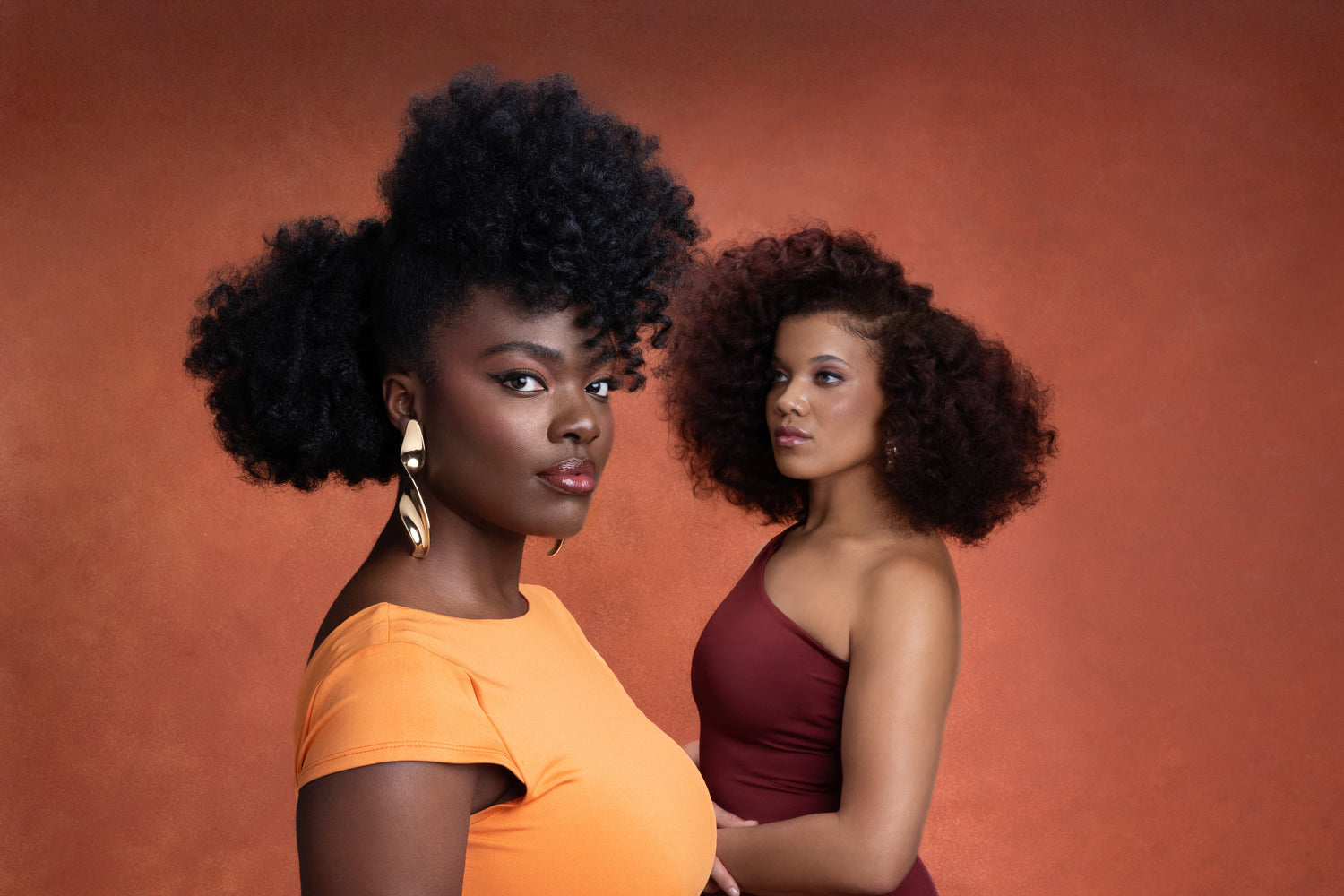Heat damage is caused by using excessive heat/heated styling tools on your hair and can make your hair feel and look dry, thin, rough, brittle and dull. You may notice you have increased hair breakage, while your ends may be split and broken with white bits showing at the ends. Heat damaged hair can even become discoloured (especially if you have dyed or bleached hair) and notice more tangles and knots (even on a hair strand).
What Exactly is Heat Damage?

If you have ever used a blow-dryer, hot flat or curling iron, or any other heat styling tool to 'tame' or style your curls and coils, you've probably heat damaged your hair because of their extreme temperatures of 70-250 °C. The increase of temperature causes increasing damage to your hair fibre from the outside to the inside.
Here is an example of when your hair is wet and you decide to blow dry your hair. The average temperature of a blowdryer is 70-100 °C. That’s significant enough to evaporate the loosely bound water from your hair and cause the hair to lose its elasticity, flexibility and to increase its friction. This causes the cuticle to be damaged as it shows cracks and fissures on its surface and the internal lipids (like 18-MEA) to be diminished, which then causes a rough feel and dull look. Interestingly, a report showed that holding the blowdryer 15 cm away from your hair causes less damage than naturally drying your hair.
However, as you increase the temperature, especially when you use flat or curling irons, the more irreversible damage you cause and deeper into the cortex you go. Such styling tools utilise temperatures between 110-250 °C. These temperatures cause a physical and mechanical changes to your hair proteins.
Now, it's time for the science of heat damage. The heat causes the strongly bound water to be removed, causing the bonds within the keratin to change and transform. Your cortex is made of keratin composed of different amino acids. Each layer of the hair fibre presents keratin in different ways. In the cortex keratin is made of two structures; a water-penetrable 'amorphous' (irregularly shaped) structure, made of keratin-associated proteins, and blocks of intermediate filaments. They are bonded and work together to provide strength, structure, support and cohesion between the cortical cells.
Unfortunately, these are the exact structures that get destabilised by heat. Your natural hydrogen and disulphide bonds and their interaction within the cortex are responsible for your curl pattern. Therefore, when their bonds are broken or changed, they rearrange in different positions to change the shape of your hair, for instance, to make it straight.

Also, the water evaporation causes the cysteine-rich 'amorphous' structure to stiffen up. This is caused because proteins cross-link (therefore, disulphide bonds still exist) while the hydrogen bonds of the water molecules are replaced by temporary salt bonds. The combination between disulphide and salt bonds are responsible for your hair being straight. Such changes can be reversible up to a point – your natural curl pattern can bounce back even at low humidity.
The more heat (220-250 °C) or more frequently you pass the iron on your tress, your keratin denatures and sulphur-containing inorganic gases are produced which weaken your hair irreversibly, while the water in the amorphous matrix keeps on reducing.
At such high temperatures, the tightly intermediate-filament- bound water evaporates which causes the α-helix protein conformation of your natural curly hair to be transformed and 'unfold' into a β-sheet conformation. It gets more and more difficult for the water to penetrate and bond with your keratin fibres, worsening the stiffening and crystallising effect. Once your hair is damaged by high temperatures, less and less water can be stored. As a result, your hair feels dry, brittle and rough.
Can The Sun Cause Heat Damage to My Hair?
The sunlight has three emissions that reach the Earth in a decreasing size order with the smallest being the most damaging: Infrared (you may feel it as heat), Visible light (you can see it as colours or light), and Ultraviolet Radiation (UVA/B/C(/R) you cannot see it).
Essentially, wherever there’s sun, there’s going to be damage, but it will vary depending on the emissions you focus on. For instance, you may think that sun heat (Infrared light) may be damaging because of the heat, but actually if you see through an infrared camera even in the daylight, you will notice your hair has a slightly lower temperature than your whole body. Also, the temperatures from the sun are much lower than when you use heat tools, maybe with the exception of Red Infrared Light Therapy (Low Level Laser Therapy or Cold Laser Therapy) as it has been proven to work against hair loss in patients with Androgenetic alopecia.
The most hair damage reported in the research field focuses on UVR with more negative outcomes on the hair’s properties both before and after it grows out of the scalp. The hair follicles may get microinflammations within the hair follicle and sustain stem cell and tissue injury, resulting in increased thinning and shedding. Moreover, after the hair emerges, UVB cause the hair cuticle to be severely damaged with lifted cuticles and fissures, thinner and fewer cuticle layers, while UVA decreases the content of integral lipids (such as free fatty acids) and the hair fibres can be discoloured. These reactions are caused because specific amino acids in keratin, like tyrosine and tryptophan, can absorb the UVB, creating free radicals which ultimately, photo-oxidise the hair and break the disulphide bonds between the proteins.
In short, it's best practice to cover your head and hair with a brimmed hat to make sure your hair, scalp and skin are protected from the sun.

What Are The Symptoms Of Heat Damaged Hair/Sun Damaged Hair?
Sun damaged hair and heat damaged hair share most of their symptoms. Your hair feels and looks dry, thin, rough, brittle and dull. You may notice you have increased hair breakage, while your ends may be split and broken with white bits showing at the ends. Your hair can get discoloured (especially if you have dyed or bleached hair). The only significant difference is that, heat damaged hair can cause more tangles and knots (even on a hair strand).
How Can You Protect Your Hair From Heat Damage?
You can’t really protect your hair from heat damage, as heat will always cause damage. But, what you can do is try to minimise its effects, especially if you are using excessive and frequent heat. There are products on the market, usually filled with ingredients like Silicones, silicone-based protein hydrolysates and polymers, that due to their polymeric composition are heat resistant and coat the hair surface well, so that the application of heat is uniform. Also, non-siliconised protein hydroxylates like Hydrolysed Quinoa have shown to protect the hair from heat damage.
How to Repair Heat Damaged Hair: What Should You Do if You Have Heat Damaged Hair?

Products marketed to repair heat damage usually contain hydrolysed proteins at 2-5% like Baobab, Wheat, Hemp and Flax Seed Hydrolysates. If you cannot afford such products or don’t really want to try them out because they may have the opposite effects (this is mainly due to using them too often), you can try different approaches.
You can drop it all together, use less heat and/or less frequently, try leave-in moisturising and deep conditioning treatments to help smooth down the cuticle which will provide more intact protection to the inner hair fibre structures.
Moisturising and conditioning products are important as they create a layer on top of your surface to help control the water content of your hair, provide some occlusivity and emolliency, and fill in and smoothen the cuticle. The cuticle is heat’s and UV’s first barrier, so taking care of it is essential to protect your cortex.
Everyday treatments using the LOC Method, with a weekly shampoo - conditioner treatment are recommended to achieve such effects. Alternatively, you can switch blow drying to using a microfibre towel turban, as it will absorb the excess water in no time, have your hair in different protective styles or use no-heat straightening techniques.
More Articles:
What is Dandruff? Why Do I Have It & How Do I Get Rid of It
Itchy Scalp? Here's What You Should Know

